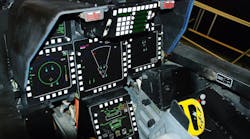By John Keller
ARLINGTON, Va. - Scientists at the U.S. Defense Advanced Research Projects Agency (DARPA) in Arlington, Va., are asking industry to develop a small hemispherical optical imaging sensor array with a 120-degree field of view and a speed of 60 frames per second.
DARPA released a broad agency announcement (BAA06-48) in late December asking for research proposals on the Hemispherical Array Detectors for Imaging (HARDI) program, which will take images in the visible, near-infrared, and shortwave-infrared optical spectra-400 to 1,900 nanometers.
The idea is to demonstrate a focal plane array integrated on a hemispherical surface that will enable high-performance imagers that are smaller and with wider fields of view than are available today. DARPA scientists want a prototype with a 1-centimeter radius of curvature with one million pixels.
The improved functionality of such a sensor array would benefit military applications by replacing the need for several detectors or gimbals and lessening the mechanical and optical complexity of the system, DARPA officials say.
Government scientists are asking for research involving innovative approaches that enable major advances in organic and/or inorganic material systems with inexpensive, easily scalable processing methods. Agency officials caution that they are not interested in research only on evolutionary improvements.
The HARDI program seeks to make the most of optical, electrical, and mechanical properties of organic and inorganic semiconductor materials and new processing methods to create compact and lightweight detection systems.
The goal is to develop photo-detectors that use fewer optical elements than today’s devices, and eliminate image post processing by inherently correcting for spherical and other optical aberrations.
DARPA is asking to see proposals in two primary areas-organic and inorganic materials and processes necessary to fabricate a hemispherical focal plane array that consists of photo-responsive materials that operate efficiently in the 400-to-1900-nanometer spectral range.
Organic materials may be organic or organic/inorganic composites. Inorganic materials could be amorphous inorganics that can be deposited and patterned on a hemispherical surface or alternately, inorganic structures prepared on a planar substrate and then transferred to a non-planar surface.
DARPA officials say they expect to award several contracts, and are encouraging collaborative efforts and teaming.
The technical point of contact for the HARDI program is Devanand Shenoy, whose fax number is 703-696-2206, and e-mail is [email protected]. A DARPA Microsystems Technology Office Website for proposers’ questions eventually will be posted at www.darpa.mil/baa/#eto. The deadline for proposals on the HARDI program was Feb. 12.


